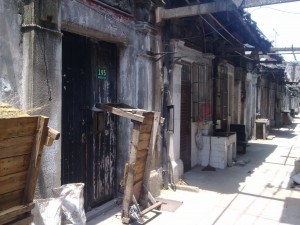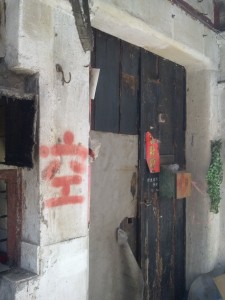Shanghai Street View: Neighborhood Nostalgia

I’ve been watching with interest these last few weeks as local media have feasted on the story of an old neighborhood in Jingan District that’s now being emptied for future development, forcing out longtime residents who have lived there for decades. I’ve been partly intrigued by the story because I’m not sure why this particular neighborhood is drawing so much attention, since this kind of redevelopment has become quite commonplace since the 1990s. More broadly speaking, I’ve also been intrigued by the heavy element of nostalgia that has oozed from this story, which perhaps reflects a new, maturing Shanghai psychology that contrasts sharply with a previous one that embraced anything and everything new.
Many of the latest reports are filled with photos from this old neighborhood, known historically as Xinkang Lane and now called Dongsiwen, located adjacent to the North-South elevated expressway near Xinzha Road. The reports are quick to point out the mass abandonment is largely voluntary, after more than 85 percent of residents agreed to sell their homes as part of the redevelopment plan.

But interestingly, none of the reports say what will actually be built on the site after everyone is gone. I’m guessing the homes, most of which lack modern plumbing and other amenities, will be demolished to make way for modern buildings like apartments, offices and perhaps even some green spaces.
It’s also interesting that the media have focused so intensely on Dongsiwen, perhaps because it’s one of the last remaining big traditional neighborhoods in the core area of old Shanghai. Whatever the case, the sudden wave of nostalgia has certainly caught me by surprise, since this kind of old area is usually best known for its unromantic scenes of streets littered with garbage and scampering rats.
I know I’ll probably take some criticism from preservationists for saying this, but I personally think that Shanghai has taken a relatively balanced approach to preserving its heritage. Generally speaking, city officials seem to realize the importance of maintaining the city’s sense of history and usually try to save famous sites from the wrecking ball.
That can mean saving buildings that are architecturally significant, but equally important it also means preserving ones that were significant because of who lived there or what happened inside them. My old neighborhood in the Hongkou District is a great case of this latter kind of preservation, containing preserved homes of numerous famous intellectuals and a small museum in the former residence of Lu Xun, one of China’s most influential 20th century thinkers.
While these kinds of historically significant buildings are worth saving, there are many others in Shanghai that are simply old but otherwise not very noteworthy. Let’s not forget that Shanghai was once one of Asia’s most advanced cities, boasting some of the region’s most modern architecture and technology in its heyday in the first half of the 20th century.
But its development slowed down sharply after 1949, with the result that the city was almost like a time capsule full of architectural relics at the start of the reform era in the 1980s. I still can vividly recall the Shanghai I saw on my first visit to the city in 1987, including its huge neighborhoods of dilapidated buildings where most people lived. I stayed in one of those buildings during that visit, and vividly remember the strangeness of using chamber pots in houses that had no running water, and having to bathe in local shower houses that were themselves rather dirty.
In its rush to move into the 21st century, Shanghai began indiscriminately knocking down many of these older neighborhoods in the 1990s, most likely losing some important historical landmarks in the process. But the redevelopment zeal seems to have eased in the last few years, with the result that there’s usually at least some debate whenever someone wants to tear down a building with even the smallest potential historical significance.
All of that brings us back to the present, where there seems to have been little or no debate over Dongsiwen, most likely because it’s just one of the city’s quickly disappearing older neighborhoods. I do find the sense of nostalgia surrounding this latest development quite new and even refreshing, as it contrasts with previous indifference by outsiders or defiance by residents who didn’t want to leave.
Perhaps this nostalgia is a sign that Shanghai, after years of breakneck development, is starting to finally realize that its simpler past wasn’t all that bad, and that demolishing that past isn’t the only way forward.
Even I found myself feeling slightly nostalgic when looking at all the old photos and reading the stories of people who were quietly packing up their belongings as they left their homes of decades for new, more modern residences. Perhaps officials in Jingan will feel the same way and mark the area for preservation, even though I suspect that most of these old, decaying houses will ultimately be marked with the all-too-familiar chai character that dooms them to demolition.
